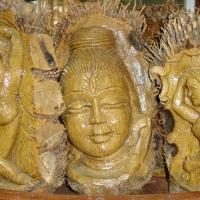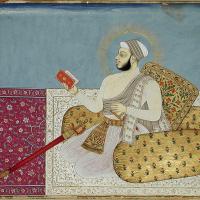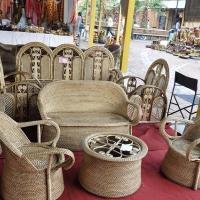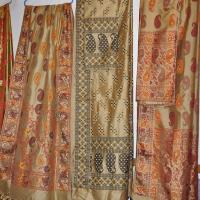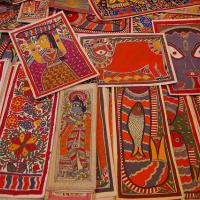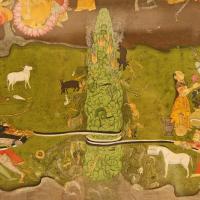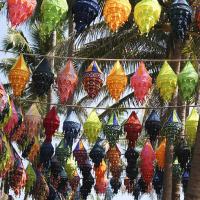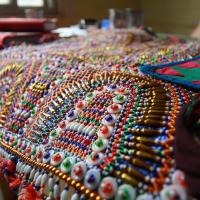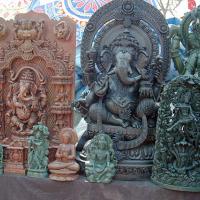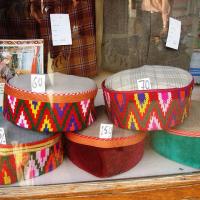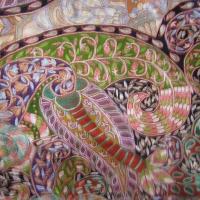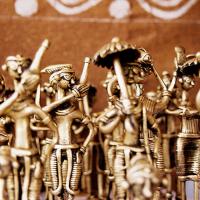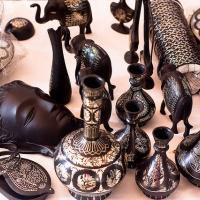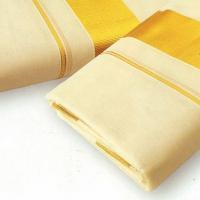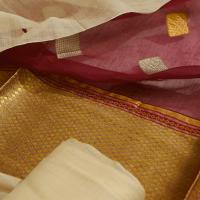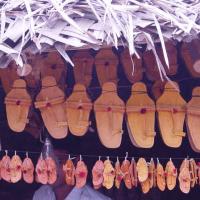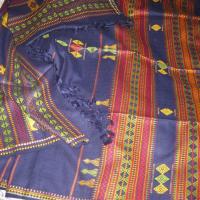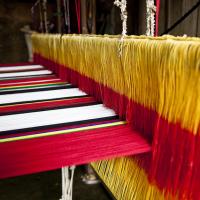The Andaman & Nicobar Islands are a long chain of islands located in the southeastern part of the Bay of Bengal and are adeal tourist destination in India. Dominated by tribals, the craft of the region, display the creative aspects of the tribals who dexterously and artistically work on crafts.
Wood and other forest products are available here in abundance. Padauk, Badam and Gurjan are the main varieties of useful timbers found on these islands. Canes and bamboo are also available in large amounts. There are also lots of coconut trees in Andaman & Nicobar.
Arts & Crafts of India
The crafts of Andhra Pradesh are well known for their aesthetic and utilitarian value. The tradition of craft in Andhra Pradesh has been carried on for generations and has become industries in themselves.
Be it toys, metal crafts, brass ware, stone craft, sarees or paintings, the expertise of artisans lie in the traditional practices that are still observed to make things. The handlooms of Andhra Pradesh have an appeal that allures not only Indians but foreigners as well, with their rich texture.
Arunachal Pradesh has a rich tradition of Bamboo and Cane Handicrafts and also Wood Carving and Carpet Weaving. The products reflect the rich and varied culture of the tribes inhabiting this enchanting State and the products featured are representative of the wide range of Handicrafts produced in the State.
From the viewpoint of the art and culture the state may be very conveniently divided into three zones. The first of these zones includes the Buddhist tribe; the second occupies the central part (from east Kameng in the west to Lohit in the east); and the third zone is the eastern part of the territory.
Assam is a confluence of a number of tribes and cultures and this is reflected in the traditional handicrafts of the place as well.
The particular field in arts and craft of Assam that is known internationally is the intricate workmanship in the textiles. The various multitude of true workmanship is also found in the work of cane and bamboo, metals crafts, handlooms, toys, pottery, woodcraft, jewellery and traditional painting.
This art form belongs to the nomads and gypsies of Andhra Pradesh. The embroidery of this form is live and vibrant. Banjaras in Andhra Pradesh display their colorful lifestyle through their exuberant clothes. It differs from the embroidery of Gujarati and Kutch Banjara. It has a style of its own, the originality and brightness are accentuated by its matchless quality. Needlework is an integral part of this craft and patterns are basic geometric combinations, squares, triangles and diamonds.
Bihar has a rich historical past. Some great name of Indian History like Ashok, Chandragupta Mauryan and the symbol of peace and non-violence Gautam Buddha had their root in Bihar. Some of the great religions of the world like Buddhism and Jainism had sprouted form here. Thus naturally Bihar is rich with varied arts and crafts. Throughout the generation the rich heritage of art and crafts has been preserved though there are slight variations due to introduction of modern technologies.
Chhattisgarh is a land of rich culture and heritage and is home to many arts and crafts apart from fine museums, galleries and tourist attractions of the place. The tourist is sure to be enchanted by the various crafts of Chhattisgarh that are sublime and exemplary in nature.
Chhattisgarh is a state renowned for its rich metal crafts and other traditional craft products made out of bamboo, wood etc. The folk paintings of Chhatisgarh depict the living expressions of the people, intrinsically linked with the socio-cultural ambiance of the area. They are not mere decorations but also spontaneous outpourings of religious devotions. The main craft produce of the State include Bamboo work, Wood carving, folk painting and folk Jewelry.
Dadra and Nagar Haveli are tiny Union territories, as are Daman and Diu. Dadra and Nagar Haveli are famous for the production of leather slippers and weaving of bamboo mats and baskets.
The chief crafts at Dadra and Nagar Haveli are the production of leather slippers, which are meant for regular use.
Mat weaving is an important traditional craft of Dadar and Nagar Haveli, which has now developed in to a full-fledged industry. Traditional motifs are used to weave bamboo mats.
Diu is known for its tortoise shell and ivory carving.
The people of Daman and Diu are not different from the people in the adjoining Gujarat area. They have same outlook and the same customs and traditions.
The famous crafts of Daman are mat weaving. Traditional and folk motifs are used to make beautifuk mats.
The famous crafts of Diu are tortoise shell crafts.and ivory carving. The different varieties of tortoise found on the shores of Diu have enabled the development of tortoise shell craft. Several decorative and household items are made out of tortoise shells. Ivory carving is another exquisite form of art.
Delhi has been the seat of administration of several rulers in the past and therefore the royalty patronized the arts and crafts of the region. It was the hub of crafts in ancient India and still maintained the tradition of craft making. The range of crafts in Delhi include: Blue pottery, jewellery making, zardozi embroidery, silver paper and toy making.
This tiny state in the south western Indian coast is also a home to varying handicrafts.It can be said that art virtually runs in Goa's blood, which is manifested, in many artistic crafts that have attained commercial proportions.
The major art forms of Goa include bamboo craft, woodcarving, brass metals, seashell craft, Papier-Mache, and wooden lacquer ware. Other important crafts of the state include Jute Macrame, Fabric Collage, Plaster of Paris, Crochet and embroidery, fiber and Batik prints, fiber stone carving, Coconut shell carving, metal embossing, silver and imitation jewelry, cotton dolls, soft toys, woolen tapestry, and artistic weaving.
The handicraft emporium, Taksha emporium and Goa handicrafts in Panji are self explanatory about their skill.
From the early civilizations, Gujarat is home to handicraft traditions. Gujarat is the storehouse of crafts, which has been deftly passed on from generation to generation.
The crafts have a hereditary basis and are replete with vibrancy. The fascinating textiles, elaborately carved wooden and stone jharokhas, bandhini and intricately carved silver jewelry are some of the famous crafts of the state. The handicrafts of Gujarat are famous for their color scheme, detail and intricate work and artistic appearance.
In Gujarat it is customary for a bride to have exquisite hand embroidered ghagras, odhnis, animal covers, bags, quilts and house decorations as part of her trousseau.
Crafts of Haryana have never been widely acclaimed but have always supported the local economy. The crafts have never received any royal patronage like the crafts of other states. However, Haryana has come up with interesting localized crafts like pottery making, handloom, artistic pottery and woodcarving.
Other craft products include the tilla juttis of Rewari and the educational toys made in Gurgaon.
The geographic isolation of Himachal has allowed its people to evolve their own unique tradition of handicrafts. The mind-boggling range includes fine woodwork, traditional leather embroidery, beautifully patterned carpets, traditional woollen shawls and lots of other things.
Jammu and Kashmir has a rich heritage with respect to art and craft. There are several tribes living in different parts of the state. Each of these tribes has their own tradition and culture and it is still reflected in the day-to-day items like clothes, utensils etc.
Most famous and most visible are the Pashmina shawls, woolen textiles of fleecy soft texture and matchless excellence in weaving, hand-woven carpets of finest warp and weft, handicrafts and clothes worn by the locales, exquisite designs worked on papier-mâché, wood work, silverware, etc.
Jharkhand is dominated by the tribals and is known for its woodwork, bamboo works, pitkar paintings, tribal ornaments and stone carving.
Karnataka is a treasure trove of an extensive array of exquisite art and crafts. These indigenous crafts, reflecting the rich heritage of the state, have survived the ravages of time due to the dedicated efforts of the artisans and sculptors. The crafts of Karnataka have received patronage from the royalty in the past. The crafts have passed on from generation to generation and bear testimony to the skill, aesthetic sensibilities and decorative abilities of the craftsperson.
Kerala is a land of artistic people. It is almost like the natives of Kerala have art in their blood. The variety of arts and crafts in Kerala is very lively and emphasize a lot on the use of colors.
Kerala is a land of artistic people. It is almost like the natives of Kerala have art in their blood. The variety of arts and crafts in Kerala is very lively and emphasize a lot on the use of colors. You will find intricate designs and vibrant details on Kerala art and craft. In fact, handicrafts in Kerala are pretty much popular and there is a whole festival dedicated just to handicrafts.
Lakshadweep is a land blessed with the best of nature. Known for everything different, tribal people in Lakshadweep have given birth to unique handicrafts and dance forms. The art and crafts of Lakshadweep have strange resemblance with that of Kerala because the people of Lakshadweep are very much similar to that of Keralites.
Madhya Pradesh, situated in Central India, witnesses more diversity than any other state in the country. It is an enchanting cosmos of landscaped beauty, heritage monuments, historical shrines and a vibrant culture. The most noteworthy of everything is the tribal heritage of the state. Home to different tribes and aborigines; the tribal matrix has begotten the inimitable handicrafts of the region. Infact, the art and craft prevalent in Madhya Pradesh makes it an exclusive museum that showcases the indigenous beauty of Indian handicrafts, and also presents the inventive adroitness of its people.
Maharashtra has a rich cultural heritage, which is an amalgamation of different cultures and traditions. The state exudes a vibrant spirit which never dies. This spirit is visible in its traditional arts and crafts. The cave paintings at Ajanta, Warli paintings and handicrafts of Maharashtra are clear evidences of the state's cultural legacy. These beyond comparison arts and crafts of Maharashtra are enticing and exotic.
Since cane and bamboo are abundantly available basketry has been a popular occupation of the people of Manipur. Different shapes and sizes with different designs are manufactured for domestic and ritualistic.
Heijing Kharai, Phiruk & Lukmai are exclusively meant for ceremonies such as wedding, birth and death. For domestic purposes baskets like Likhai, Sangbai, Chengbon, Meruk, Morah etc. are made.
Again, there are fishing equipments made of cane and bamboo. They are Longup, Tungbol etc. People of Maring tribe inhabiting the Chandel District are the main manufacturers of these types of basket. Other tribes and the Meeteis also contribute a lot to the production of baskets.
Meghalaya has its rich traditions of different art forms – decorative arts, performing arts and utilitarian crafts and architecture. In some Jaintia and Garo villages, engravings of figures of men and animals are found on the house walls.
The crafts of Mizoram are mainly made using the locally available raw materials with deftness and artistically. The traditional patterns of the Mizos are still visible in their crafts. The products have a relatively good international demand and efforts are also being made to promote the various crafts.
Mojris/Jutis are Rajasthani footwear made up of leather and having exquisite embroidery. The pattern and design of embroidery varies from region to region. However, Jaipur and Jodhpur are the places most famous for mojris.

